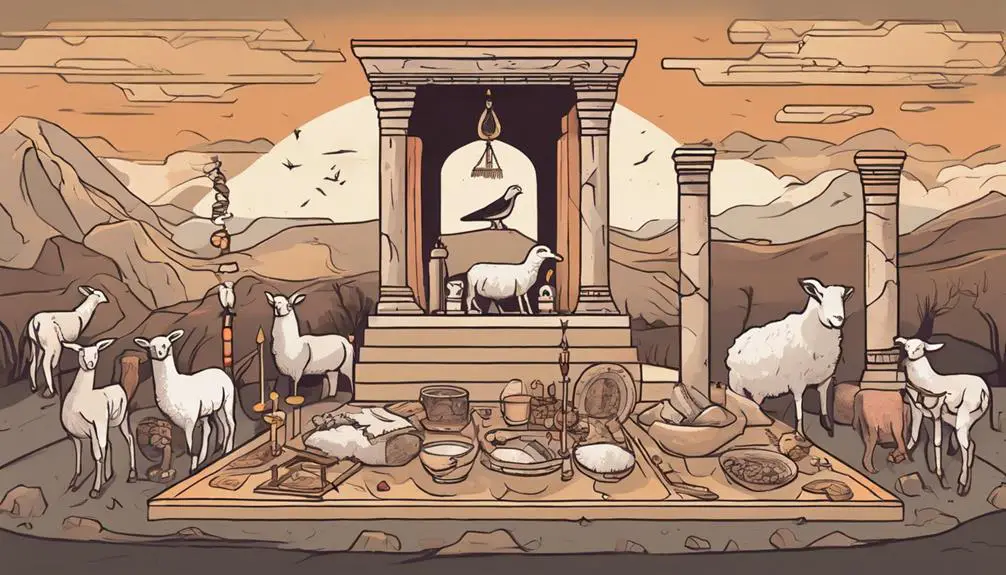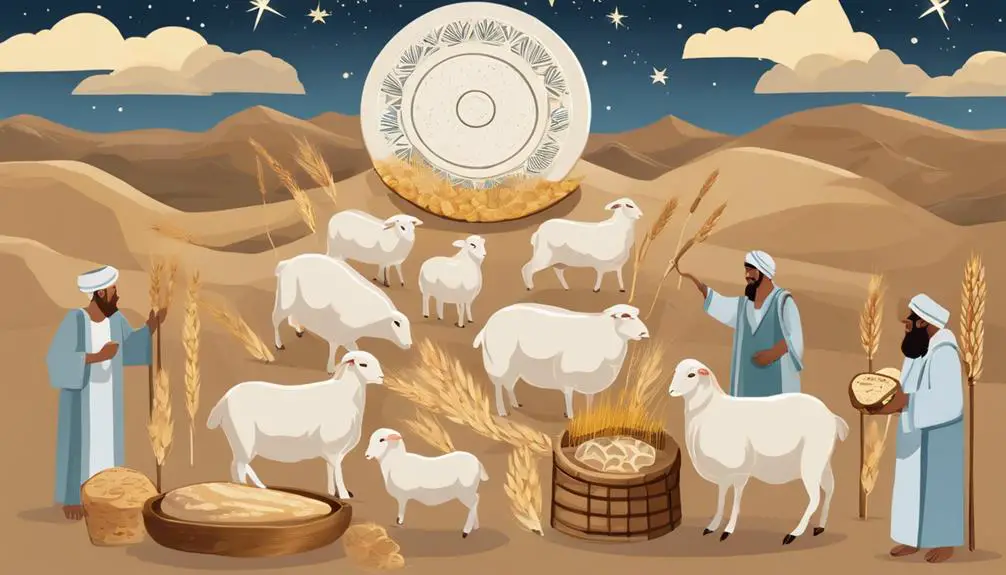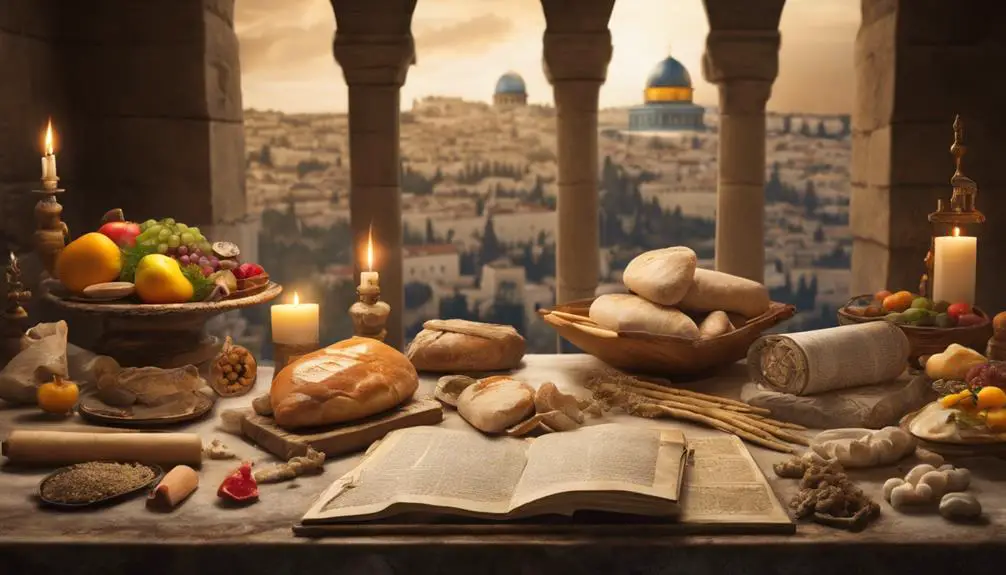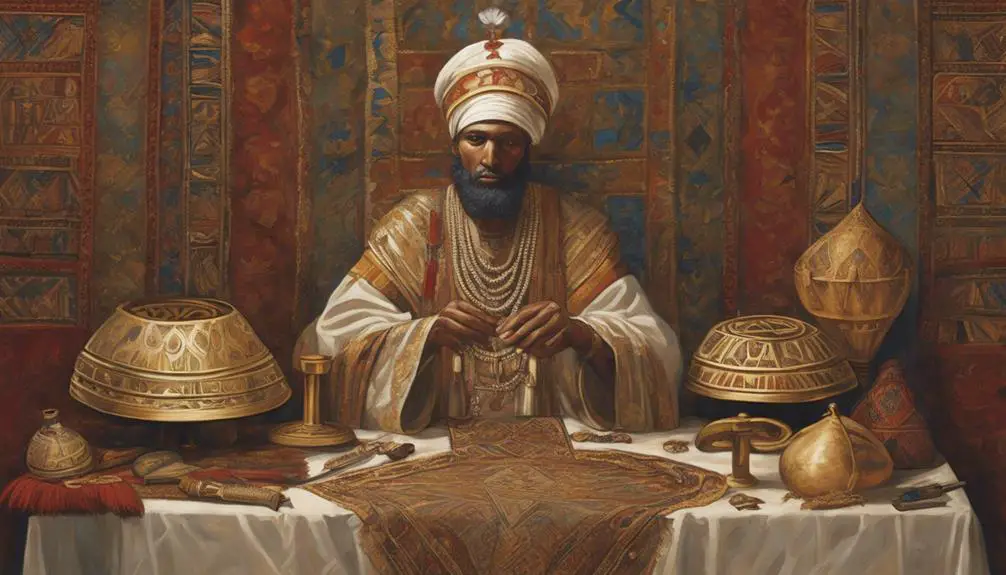Marvel at the intricate ceremonial laws of the Bible, uncovering ancient rituals and their lasting impact on modern faith.

List of Ceremonial Laws in the Bible
Navigating the ceremonial laws in the Bible is like embarking on a journey through a dense, historical forest, each turn revealing new insights into the spiritual practices of ancient times. You'll encounter sacrificial rituals that served as the backbone of religious observance, festivals that marked the rhythm of the year, and dietary laws that defined purity.
As you explore, you'll also unravel the significance of priestly duties, garments, and the profound symbol of circumcision. But what lies beneath these rituals and their relevance today? Let's peel back the layers to uncover the enduring impact of these ancient practices on contemporary faith and spirituality.
Key Takeaways
- Ceremonial laws include sacrificial offerings to symbolize atonement and devotion to God.
- Observance of holy days and festivals fosters community identity and faithfulness.
- Dietary laws and purifications distinguish clean from unclean, integrating daily life with spirituality.
- Priestly duties, garments, and circumcision signify covenantal relationships and mediate between the divine and the Israelites.
Sacrificial Rituals Explained

In the context of ceremonial laws within the Bible, sacrificial rituals play a pivotal role, embodying complex theological significances and serving as a conduit for the Israelites' communion with the Divine. Altar design, integral to these rituals, isn't merely functional; it symbolizes humanity's connection to God, structured to facilitate an array of sacrifices, including burnt offerings. You'll find that altar design is meticulously described in the Scriptures, emphasizing the sanctity and the precision required in approaching God through sacrifices.
Burnt offerings, a central aspect of these rituals, serve multiple purposes. They're meant as atonement for sins, a gesture of devotion, and a means to consecrate the worshippers. You should understand that these offerings, involving unblemished animals or, in some cases, fine flour, are wholly consumed by fire on the altar. This total consumption signifies the complete surrender of the offering to God, reflecting the worshippers' total dedication to Him.
Analyzing these practices, you'll recognize a rich tapestry of symbolic meanings. The sacrificial rituals, particularly through the meticulous design of altars and the profound significance of burnt offerings, reveal a theology deeply rooted in the principles of atonement, devotion, and consecration.
Festivals and Holy Days

Building on the understanding of sacrificial rituals, it's crucial to explore the festivals and holy days that punctuate the biblical narrative, serving as markers of time and reflection for the Israelites. These occasions not only reinforced communal bonds but also served as a reminder of their covenant with God. Among these, several stand out for their significance and the detailed observance instructions provided in the Scriptures:
- Sabbath observance: Instituted as a weekly day of rest and worship, the Sabbath is perhaps the most pivotal, serving as a constant reminder of God's creation and His deliverance of Israel from Egypt. Its rigorous observance underscored a rhythm of work and rest, integral to Israelite society.
- Passover and the Feast of Unleavened Bread: Commemorating the Exodus, this festival initiated the religious calendar year, symbolizing liberation and purity.
- Feast of Weeks (Shavuot): Celebrated seven weeks after Passover, it marked the wheat harvest and the giving of the Torah at Sinai, blending agricultural and historical significances.
- New Moon celebrations: These monthly observances were times for communal gathering, sacrifices, and reflection, underscoring the lunar cycle's importance in marking time and festivity periods in Israelite society.
These festivals and holy days, embedded within the fabric of Israelite culture, weren't merely ceremonial but deeply spiritual, fostering an enduring sense of identity, community, and faithfulness to their covenantal relationship with God.
Dietary Laws and Purifications

CURRENT SUBTOPIC: 'Dietary Laws and Purifications'
The Bible's dietary laws and rituals of purification not only delineate clean and unclean foods but also embody deeper spiritual and communal principles. You'll find that these regulations are more than mere dietary restrictions or hygiene practices; they symbolize a call to holiness and set the Israelites apart from surrounding nations.
Clean and Unclean Animals |
Washing and Bathing Practices |
|---|---|
The distinction between clean and unclean animals is meticulously outlined, emphasizing the importance of discernment in consumption. Leviticus 11 provides a detailed list, forbidding the consumption of certain creatures based on their characteristics, such as cloven hooves and cud chewing. |
Ritual purity is not just about physical cleanliness but reflects a deeper spiritual state. Numbers 19 details the necessity of washing and bathing in specific circumstances, highlighting the link between physical actions and spiritual purity. |
Eating unclean animals is seen as defiling, not just physically but spiritually, underscoring the integral connection between body and spirit in biblical thought. |
The practices of sprinkling purified water and the use of the ashes of the red heifer in purification rituals further illustrate the comprehensive approach to cleanliness and sanctity. |
These laws and practices serve as constant reminders of the Israelites' unique identity and their covenant relationship with God, integrating daily life with divine expectations.
Priestly Duties and Garments

Analyzing the roles and attire of the priesthood reveals their critical function in mediating between the divine and the Israelite community. The intricate design of their garments and the precise duties they performed underscored a deep symbolic connection with the sacred. To grasp their importance, consider the following:
- Altar Design: The priests were responsible for the upkeep and functioning of the altar, a centerpiece in facilitating communication with God. The design of the altar itself was laden with symbolism, embodying notions of sacrifice, purification, and divine presence.
- Incense Use: Incense played a significant role in priestly duties, symbolizing prayers ascending to heaven. The meticulous preparation and use of incense highlighted the priests' role in interceding on behalf of the people.
- Garment Symbolism: Every piece of the priestly attire, from the breastplate of judgment to the turban, was imbued with meaning. These garments set the priests apart, visually reinforcing their role as intermediaries.
- Ritual Precision: The priests' adherence to detailed rituals, from offerings to ceremonies, emphasized the seriousness of their mediating role. Each act was performed with exactness, reflecting the sanctity of their duties.
In essence, the priests served as the bridge between the Israelites and the divine, with their duties and garments deeply rooted in symbolism and reverence.
Circumcision and Its Significance

As a foundational rite within the biblical narrative, circumcision represents not merely a physical act but a profound covenantal sign between God and His people. This practice, commanded to Abraham as an everlasting covenant in Genesis 17, marks the male descendants of Israel, setting them apart as God's chosen people. The act of circumcision transcends mere physical alteration, embedding deep spiritual and communal significance.
Analyzing this from a modern perspective, you'll find discussions surrounding health benefits tied to circumcision. Research indicates potential reductions in the transmission of certain diseases and infections, making this ancient practice relevant in contemporary health discourse. However, it's crucial to approach these findings with a nuanced understanding of context and limitations.
The gender implications of circumcision are equally significant. This rite exclusively involves males, inherently defining gender roles within religious and cultural contexts. It's a marker of identity and belonging that directly impacts men, while indirectly shaping the spiritual and social dynamics of communities. Understanding circumcision's role in the Bible requires a multifaceted analysis, considering its historical roots, health discourse, and gendered dimensions to fully grasp its enduring significance.
Frequently Asked Questions
How Do Modern Interpretations of Ceremonial Laws Vary Among Different Christian Denominations?
You'll find that modern interpretations of ceremonial laws differ significantly among Christian denominations. For instance, dietary adaptations, once strictly observed, now vary widely. Some groups maintain traditional dietary restrictions, while others see them as symbolic.
Baptism practices also diverge, with denominations disagreeing on the method and age for baptism. These variations reflect a broader theological spectrum, where each denomination prioritizes and interprets ancient rituals through its doctrinal lens.
What Are the Historical Contexts Behind the Establishment of These Ceremonial Laws in Ancient Israel?
You're diving into the roots of ancient traditions, seeking to understand the ritual origins and societal roles that shaped them.
These practices weren't just religious expressions; they were deeply entwined with the community's identity and governance.
How Have Archaeological Findings Contributed to Our Understanding of Biblical Ceremonial Laws?
Archaeological achievements have amplified our appreciation of biblical ceremonial laws.
Digging deep, experts have excavated artifacts asserting authenticity, unveiling vast volumes about ancient practices.
These discoveries don't just dazzle; they delve into the depths of cultural symbolism, bridging biblical narratives with tangible truths.
Through careful analysis, you'll find that every shard and script sheds light, offering a detailed, scholarly perspective on ceremonies once cloaked in mystery.
In What Ways Have Ceremonial Laws Influenced Contemporary Legal Systems or Ethical Frameworks?
Ceremonial laws have shaped contemporary legal systems and ethical frameworks through cultural adaptation and legal secularization. You'll find their influence in modern laws about food, hygiene, and social justice, reflecting historical practices.
This adaptation shows a nuanced blend of ancient traditions with today's societal norms. The process also highlights how societies transform religious norms into secular laws, enriching the ethical landscape.
This evolution underscores the enduring impact of these ancient codes on modern life.
Are There Any Ceremonial Laws That Have Been Completely Abandoned or Significantly Altered in Their Practice Today, and What Prompted These Changes?
You're treading through history, witnessing the transformation of ancient practices. Many ceremonial laws have indeed been abandoned or significantly altered, a testament to cultural adaptation and societal evolution.
Factors prompting these changes range from shifts in ethical perspectives to the practicalities of modern life. Analyzing these transitions offers a fascinating glimpse into how societies reinterpret traditions to align with contemporary values and needs, revealing a complex interplay of preservation and change.
Conclusion
You might think that the myriad of ceremonial laws in the Bible are outdated or irrelevant today. However, understanding these laws offers deep insights into the cultural and religious practices of ancient communities. From sacrificial rituals to dietary restrictions, each law served a purpose in shaping the social and spiritual fabric of the time.
Moreover, examining priestly duties, festivals, and practices like circumcision reveals the complex ways faith influenced daily life. Thus, these laws aren't merely historical curiosities but pivotal in understanding the evolution of religious thought and practice.



Sign up